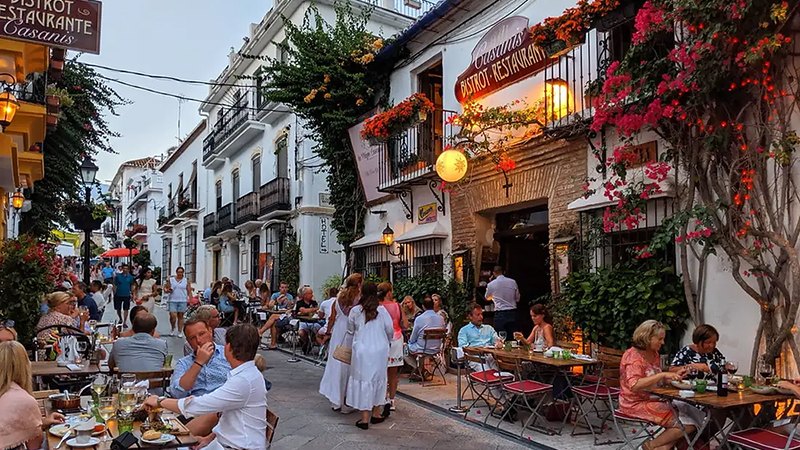
Historical Attractions in Marbella
Alexey | · 16 min. read
Marbella, nestled in the sun-kissed heart of the Costa del Sol, is celebrated for its stunning beaches and vibrant nightlife. Yet, beyond this gleaming facade, the city offers a treasure trove of historical attractions that narrate the tale of Marbella's evolution over the centuries. These sites are not mere structures; they are gateways to the past, offering visitors a glimpse into the city’s rich cultural and architectural heritage. From ancient Roman relics to majestic Moorish fortresses, Marbella's historical sites are must-visits for anyone eager to explore the city's past.
In this article, we’ll dive into the history of Marbella and explore the top historical attractions that showcase its diverse heritage. Whether you're a history enthusiast, a curious traveler, or considering a move to Marbella, these sites will provide a deeper understanding of the city's fascinating journey through time.
- Table of contents
- Overview of Marbella's History
- Exploring Marbella's Top 12 Historical Attractions
- How to Make the Most of Marbella’s Historical Sites
- Essential Considerations for Visiting Historical Sites in Marbella
- Final Thoughts: Unearthing Marbella’s Cultural Tapestry
Overview of Marbella's History
The history of Marbella is a rich tapestry woven with diverse influences, dating back thousands of years. Originally settled by the Phoenicians around 600 BC, the area was prized for its strategic coastal location which facilitated trade and cultural exchange across the Mediterranean. Following the Phoenicians, the Romans established a significant presence in Marbella, recognizing its potential as a commercial hub. They left behind remnants of their civilization, including ruins and artifacts that hint at the city’s vibrant past.
Moorish Influence and the Reconquista
During the Moorish rule, starting in the 8th century, Marbella truly flourished. The Moors transformed the town into a vital trading center, enhancing its economy and cultural significance. They constructed impressive architectural marvels, such as the old town’s winding streets and the Alcazaba, a fortress that served both defensive and administrative purposes. The influence of Moorish design can still be seen today, with intricate tile work, decorative arches, and lush gardens dotting the landscape.
Following the Reconquista in 1485, Marbella came under Christian rule, marking a significant turning point in its history. This era saw the construction of several churches and civic buildings that blended Gothic, Mudejar, and Renaissance architectural styles. This fusion of influences created a unique aesthetic that enriches Marbella’s streets and reflects its diverse cultural heritage.
As the centuries progressed, Marbella continued to evolve, becoming a popular destination for European nobility and artists in the 20th century, further contributing to its cultural richness. Today, Marbella stands as a vibrant city that honors its past while embracing modernity, inviting visitors to explore its historical sites and appreciate the stories woven into its very fabric.
Exploring Marbella's Top 12 Historical Attractions
Marbella’s historical attractions offer a unique blend of Roman, Moorish, and Spanish Renaissance influences. Below, we delve into the city’s most iconic sites, their significance, and what makes each one a unique chapter in Marbella’s story.
Historical Attractions List:
- The Alcazaba of Marbella
- The Historic Old Town (Casco Antiguo)
- Iglesia de la Encarnación
- Villa Romana de Río Verde
- Murallas del Castillo (Marbella Castle Walls)
- Capilla de San Juan de Dios
- Museo del Grabado Español Contemporáneo
- Cortijo Miraflores Cultural Centre
- Plaza de Toros
- Ermita de San Miguel
- Parque de la Alameda
- San Pedro Alcantara

1. The Alcazaba of Marbella
Standing as one of the city's most enduring monuments, the Alcazaba is a Moorish fortress dating back to the 10th century. This formidable structure was part of a defensive network that protected Marbella from invasions. Despite its partial ruins, the Alcazaba continues to impress with its strong stone walls and strategic towers, offering insights into the brilliance of Islamic architecture.
Highlights:
- Architectural Splendor: The Alcazaba features robust stone walls, strategically placed towers, and remnants of intricately designed gates, showcasing advanced Moorish architectural techniques.
- Panoramic Views: Visitors can enjoy breathtaking views of the surrounding landscape from the fortress, which underscores its strategic importance during the Islamic rule.
- Historical Significance: Built under the reign of Abd al-Rahman III, the fortress symbolized military and administrative prowess, serving as a residence for the ruling elite.
Tips for Visitors:
- Guided Tours: Opt for guided tours that bring the ruins to life with historical narratives.
- Best Time to Visit: Early morning or late afternoon offers the best light for photography and fewer crowds.
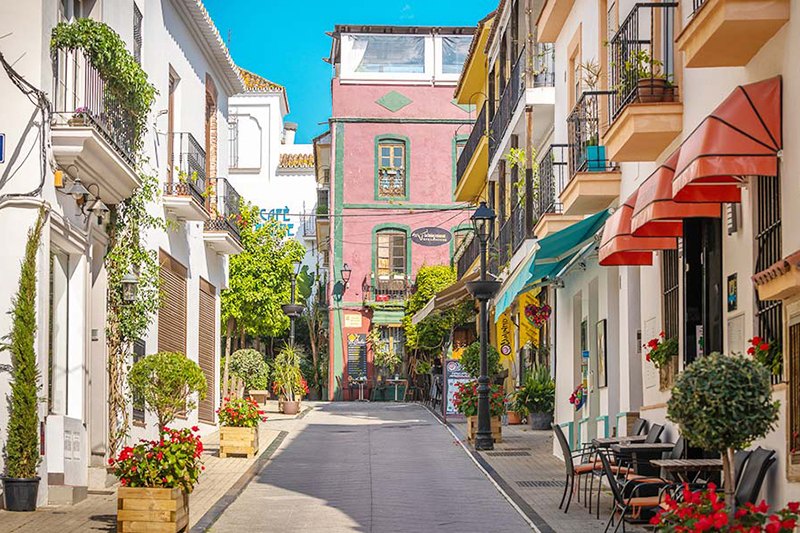
2. The Historic Old Town (Casco Antiguo)
At the heart of Marbella lies its charming Old Town, a labyrinth of narrow, winding streets that open up into picturesque plazas. The jewel of this area is Plaza de los Naranjos, a serene and vibrant square lined with orange trees and flanked by historical landmarks, bustling cafés, and boutique shops.
Key Attractions:
- Plaza de los Naranjos: Established in 1485, this square is surrounded by significant structures, including the Town Hall and Santiago Chapel.
- Ermita de Santiago: The oldest religious building in Marbella, offering insights into the city’s ecclesiastical history.
- Casa del Corregidor: A Renaissance-era building known for its intricate stonework and elegant façade.
Places to Eat and Dine:
- After exploring, indulge in traditional Spanish tapas at one of the many eateries around Plaza de los Naranjos.
Tips for Visitors:
- Wear Comfortable Shoes: The cobblestone streets can be uneven.
- Time to Wander: Dedicate time to simply meandering through the streets and discovering hidden gems, like small art galleries and local shops.
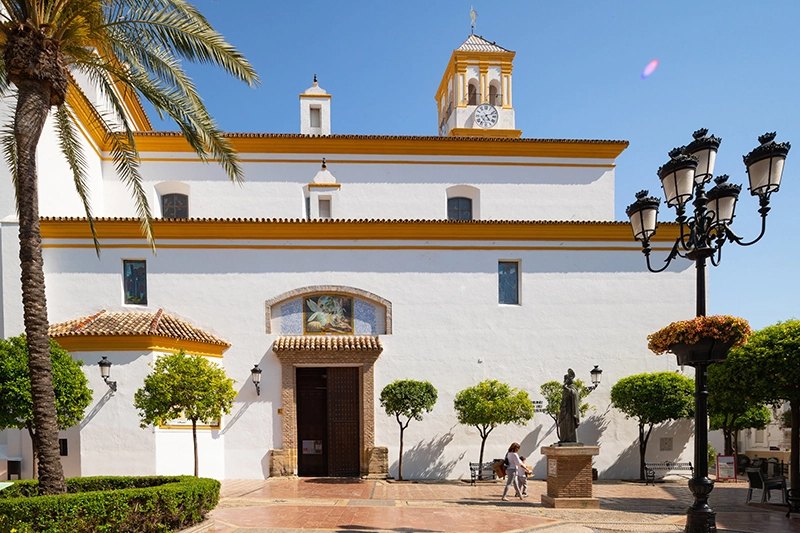
3. Iglesia de la Encarnación
In the heart of the Old Town, the Iglesia de la Encarnación stands as a masterpiece of Gothic, Baroque, and Renaissance architectural styles. This church was built in the 16th century after the Reconquista and remains a symbol of Marbella's religious history and cultural diversity.
Architectural Beauty:
- Majestic Bell Tower: The church’s bell tower is an iconic landmark that can be seen from various parts of the city.
- Intricate Altarpiece and Nave: Inside, visitors will find beautifully designed altarpieces, elaborate stained-glass windows, and frescoes that depict religious themes.
- Blend of Styles: The church reflects a fusion of architectural influences, marking Marbella's transition from Moorish to Christian rule.
Visitor Information:
- Attend Sunday Mass: Experience the church’s spiritual ambiance.
- Cultural Events: The church occasionally hosts events and concerts, adding to the experience.
Tips for Visitors:
- Check Schedules: Verify opening hours and event schedules ahead of time on the official Marbella tourism page.
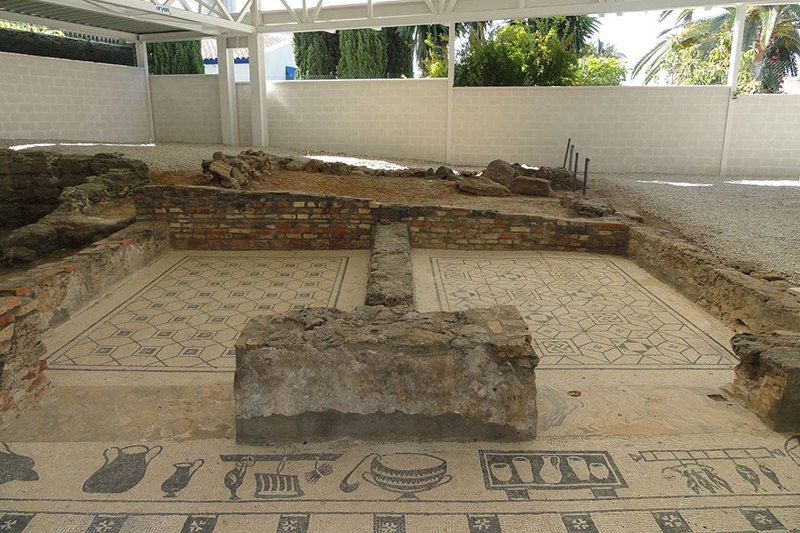
4. Villa Romana de Río Verde
This archaeological site, discovered in the 1960s, offers a glimpse into the luxurious lifestyle of ancient Romans. Villa Romana de Río Verdeilla features exceptionally well-preserved mosaics that date back to the 1st century AD, highlighting Roman architectural and cultural sophistication.
Key Features:
- Intricate Mosaics: The mosaics feature themes from Roman mythology and daily life, demonstrating incredible detail and artistry.
- Roman Bathing Areas: The villa’s bathing areas reflect the Romans' emphasis on hygiene and leisure.
- Interpretive Panels: Informative displays guide visitors through the history and significance of the villa.
Tips for Visitors:
- Plan Ahead: Check for guided tour availability to fully appreciate the villa’s historical context.
- Visit During Off-Peak Hours: To explore at your own pace without the crowd.
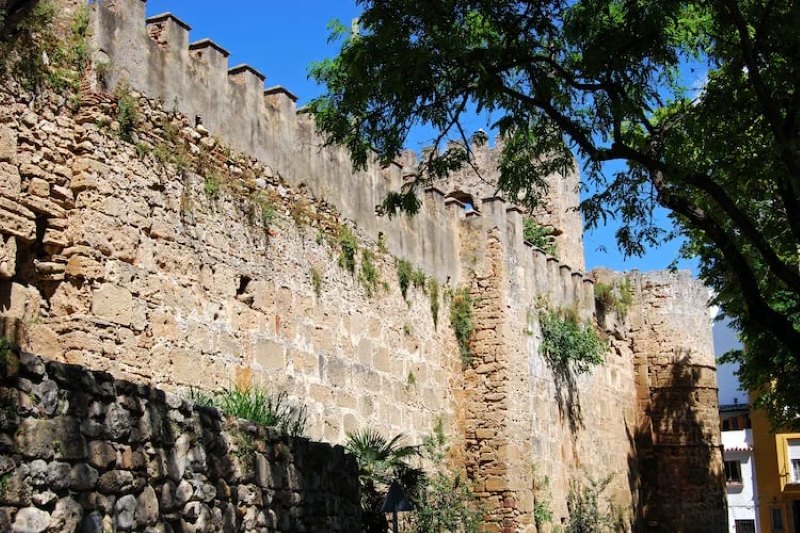
5. Murallas del Castillo (Marbella Castle Walls)
Marbella's rich Moorish past is reflected in the Murallas del Castillo, or the Castle Walls, which once served as the fortification of the city. Built during the 10th and 11th centuries, these walls were part of a larger defensive structure that protected the Alcazaba and the medina (old town) during the Islamic rule.
Historical Significance: The castle walls were erected during the Caliphate of Córdoba, a period when Marbella was a strategic outpost. Though much of the original structure has been lost to time, sections of the wall remain standing, giving visitors a glimpse into the architectural prowess of the Moors.
What to See:
- Ancient Towers: The walls feature a few remaining towers that would have been used for lookout and defense, strategically positioned to monitor the surrounding area.
- The Gateways: Some of the old gates leading into the city have been preserved, hinting at how the city was once accessible through these fortified entrances.
- Nearby Gardens: Visitors can enjoy the surrounding gardens, which make for a peaceful stroll and offer scenic views of the remaining structures.
Tips for Visitors:
- Wear Comfortable Shoes and Bring a Camera - To capture the contrast between the historic walls and the modern-day Marbella skyline.
- Explore the Area - To get a sense of stepping back in time while still being in the heart of the city.
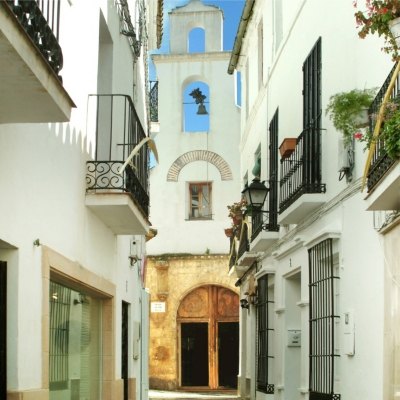
6. Capilla de San Juan de Dios
Tucked away within the winding streets of Marbella’s old town, the Capilla de San Juan de Dios is a small yet significant religious site. Constructed on the site of a former mosque, this chapel symbolizes the shift from Islamic to Christian rule following the Reconquista.
Historical Significance: The chapel dates back to the 16th century and was part of a hospital established by the Catholic Monarchs. Its foundation marked the transformation of the region’s religious landscape, as many mosques were either destroyed or repurposed. Today, it stands as a symbol of Marbella’s layered history.
What to See:
- Intricate Interior: Though modest from the outside, the chapel's interior features classic Andalusian details, such as beautiful tile work and traditional altarpieces.
- Historical Artifacts: Various religious artifacts are displayed within, offering a glimpse into the spiritual life of past eras.
- Nearby Cultural Spots: Located close to the Plaza de los Naranjos, visitors can easily include this chapel in a tour of the historic old town.
Tips for Visitors:
- Visit During Off-Peak Hours: To experience the chapel’s tranquility. Photography is generally allowed, but be respectful of any ongoing religious activities.

7. Museo del Grabado Español Contemporáneo
Housed in the historic Hospital Bazán, Museo del Grabado Español Contemporáneo museum is dedicated to Spanish engravings and prints. The museum features an extensive collection of works by notable Spanish artists, including Salvador Dalí and Pablo Picasso.
Features:
- Diverse Collections: Explore contemporary engravings that reflect Spain's artistic evolution through the centuries.
- Cultural Events: The museum hosts workshops and exhibitions that encourage public engagement with the arts.
Tips for Visitors:
- Check for Special Exhibitions: Special events or temporary exhibitions often feature unique works, so stay updated on the museum’s schedule.
- Combine Visits: Pair your visit with a trip to the nearby old town for a day full of culture and history.

8. Cortijo Miraflores Cultural Centre
This cultural center is situated in a beautifully restored farmhouse and offers a variety of programs dedicated to the arts, education, and community engagement. Cortijo Miraflores Cultural Centre serves as a hub for artistic expression, showcasing local talent and hosting diverse cultural events.
Features:
- Art Exhibitions: Rotating exhibitions highlight the work of local artists and artisans, providing a platform for creative expression.
- Workshops and Classes: Regular workshops on various arts and crafts, ranging from painting to ceramics, cater to all skill levels.
- Community Events: The center often organizes events, performances, and festivals that engage the local community and visitors alike.
Tips for Visitors:
- Check the Calendar: Look for upcoming events or exhibitions on the official website to maximize your visit.
- Bring the Family: Many programs are family-friendly, making it an excellent spot for visitors with children.
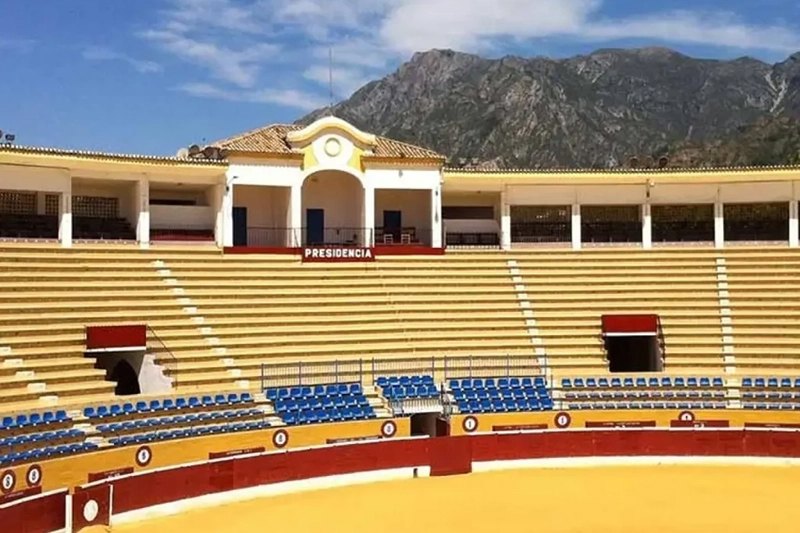
9. Plaza de Toros
The Plaza de Toros in Marbella is an iconic bullring that reflects a significant aspect of Spanish culture. Opened in 1900, this historical venue hosts traditional bullfighting events, drawing both locals and tourists.
Historical Significance: The bullring is not just a sports arena but also a symbol of Andalusian tradition. Its architecture showcases the classical style associated with bullrings across Spain, making it a noteworthy site for architecture enthusiasts and cultural observers alike.
What to See:
- Bullfighting Events: Check the schedule for any ongoing bullfighting events or festivals.
- Museum: The attached museum features exhibits on the history and culture of bullfighting in Spain.
- Guided Tours: Explore the ring and learn about its history through guided tours available to visitors.
Tips for Visitors:
- Photography: Capture the unique architecture of the ring, but be mindful of any restrictions during events.
- Visit in Season: Bullfighting season typically runs from April to October, so plan your visit accordingly.
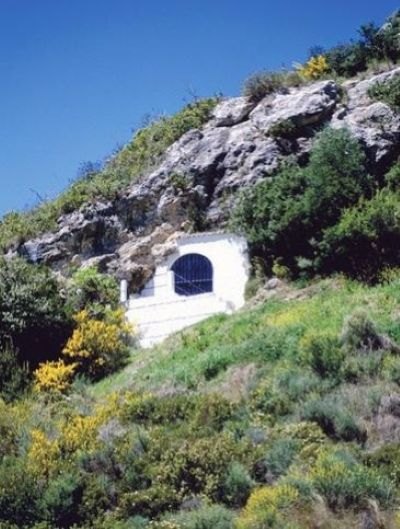
10. Ermita de San Miguel
The Ermita de San Miguel is a charming chapel located in the hills overlooking Marbella, offering a peaceful retreat and panoramic views of the surrounding areas. It dates back to the 18th century and is a site of local pilgrimage.
Historical Significance: The chapel was constructed in honor of San Miguel, the patron saint of Marbella, and remains a place of worship and reflection. Its quaint design and serene environment make it a popular spot for both locals and visitors seeking tranquility.
What to See:
- Picturesque Setting: The chapel is surrounded by beautiful gardens and pathways, perfect for leisurely strolls.
- Religious Significance: Visitors can learn about the local traditions associated with the chapel, including annual celebrations.
Tips for Visitors:
- Visit During Festivals: Time your visit to coincide with local celebrations, when the chapel is particularly vibrant.
- Bring a Picnic: Enjoy a picnic in the gardens while taking in the stunning views.
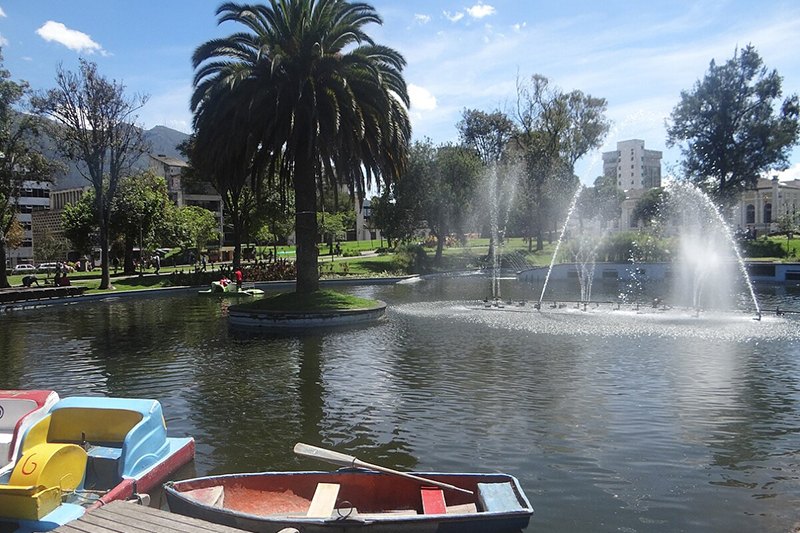
11. Parque de la Alameda
Parque de la Alameda is a beautiful park, located near the Old Town that features lush gardens, fountains, and vibrant flowers, making it an ideal spot for a leisurely stroll or a peaceful retreat from the bustling city.
Key Features:
- Beautiful Landscaping: The park’s well-maintained gardens provide a serene environment for relaxation.
- Historical Statues: Several sculptures and monuments reflect Marbella's rich history.
- Community Events: The park often hosts cultural events and markets, making it a lively gathering place.
Tips for Visitors:
- Bring a Book: Enjoy some quiet time in the shade of the trees with a good book.
- Visit Nearby Attractions: The park is conveniently located near other attractions, allowing for a comprehensive day of exploration.
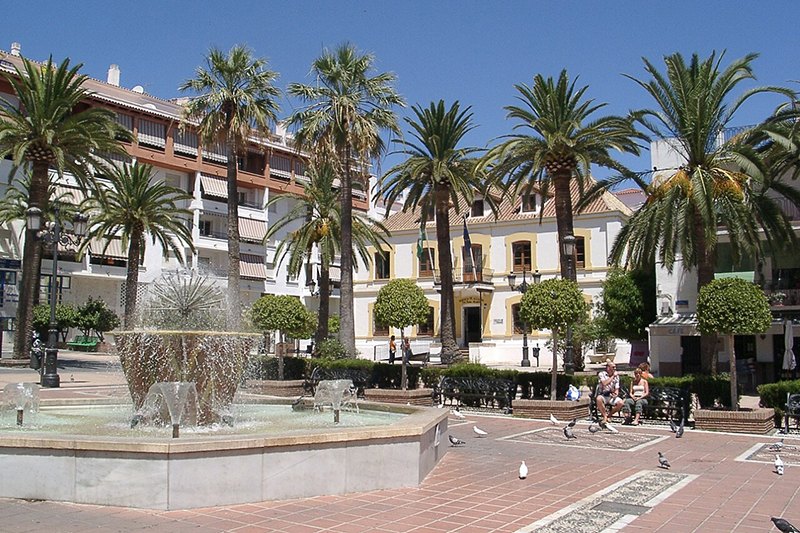
12. San Pedro Alcántara
Just a short drive from Marbella, San Pedro Alcántara is a charming coastal town that offers a more local experience. Known for its beautiful beaches and traditional Spanish architecture, it’s a fantastic spot for those looking to escape the tourist crowds.
Key Features:
- Plaza de la Iglesia: The central square is surrounded by quaint shops and restaurants, perfect for soaking in local life.
- Promenade: A lovely seaside promenade ideal for walks, jogging, or cycling, lined with palm trees and beach bars.
- Local Markets: Experience local culture by visiting the weekly market, where vendors sell fresh produce, crafts, and more.
Tips for Visitors:
- Timing: Visit during the week for a quieter experience, especially in the off-peak season.
- Try Local Cuisine: Don't miss the chance to sample local tapas in one of the town’s charming restaurants.
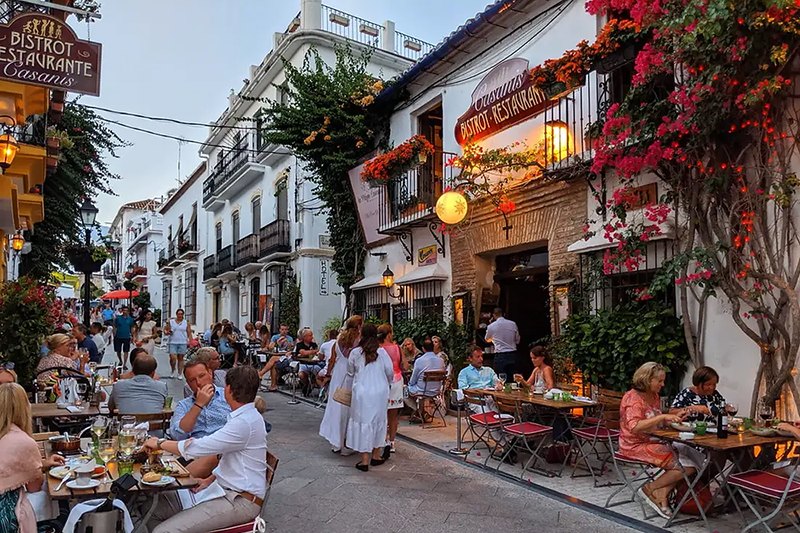
How to Make the Most of Marbella’s Historical Sites
Exploring Marbella's historical attractions is like stepping into a time machine that takes you through centuries of diverse cultures and architectural marvels. From Roman baths to Moorish fortifications, each site has its own story to tell. To ensure you have an enriching and enjoyable experience, consider these essential tips that will help you navigate, appreciate, and fully immerse yourself in the history of this stunning coastal city.
- Plan Your Route: Some of the historical attractions are within walking distance, especially in the Old Town. Plan your route to avoid backtracking and make the most of your day. Check out our guide here about the available public transportation options in Marbella so you can better plan your route.
- Respect the Sites: Remember, these are not just tourist attractions but cultural heritage sites. Respect the rules, such as no flash photography in certain areas.
- Local Guides: Hiring a local guide can greatly enhance your understanding of the sites, especially for locations with rich backstories, like the Alcazaba or Roman villas.
Essential Considerations for Visiting Historical Sites in Marbella
Visiting historical landmarks requires a certain level of care and consideration to preserve their integrity for future generations. Whether it’s your first time exploring historical sites or you’re a seasoned traveler, keeping a few important things in mind will make your visit more respectful, enjoyable, and memorable. Here are some key points to remember when planning your historical adventure in Marbella.
- Accessibility: Some historical sites may have limited accessibility, especially for visitors with mobility issues, due to their ancient structures. Check in advance to plan accordingly.
- Weather Considerations: Marbella’s summer can be hot, so carry water, wear sunscreen, and plan for shade breaks. Spring and autumn offer a more comfortable climate for exploring.
- Entry Fees and Timings: Check the official websites or local tourism offices for up-to-date information on entry fees, timings, and any seasonal closures or events that might affect your visit.
Final Thoughts: Unearthing Marbella’s Cultural Tapestry
Marbella’s identity extends far beyond its glittering beaches and vibrant nightlife. The city’s historical attractions are gateways to the past, revealing layers of cultural and architectural richness shaped by diverse influences. From the majestic Moorish Alcazaba to the intricate Roman mosaics, each site tells a unique story. These landmarks aren’t just places to see; they are experiences that immerse you in Marbella’s heritage.
While exploring the city, don’t miss out on the opportunity to relax on some of Marbella’s best beaches or indulge in its renowned nightlife scene. After a day of sightseeing, treat yourself to ultimate relaxation at a luxurious spa.
For history buffs, new residents, or curious travelers, visiting these historical gems will deepen your appreciation for Marbella’s vibrant past and present. Along the way, you can also experience the area’s diverse offerings, such as its world-class golf courses and exquisite dining options.
Key Takeaways:
- Plan your visits to include guided tours where possible, as they can greatly enhance your understanding of each site.
- Respect the preservation efforts by following all rules and guidelines when exploring historical attractions.
- Take time to explore not just the main landmarks but also the hidden gems scattered throughout the city and its surrounding areas.
Marbella’s historical attractions offer more than just a glimpse into the past—they provide a rich tapestry of cultural influences that have shaped the city into what it is today. By exploring these landmarks, visitors can help boost sustainable tourism in Marbella while also connecting with the city’s multifaceted history and gaining a deeper appreciation for the city’s unique blend of old and new.